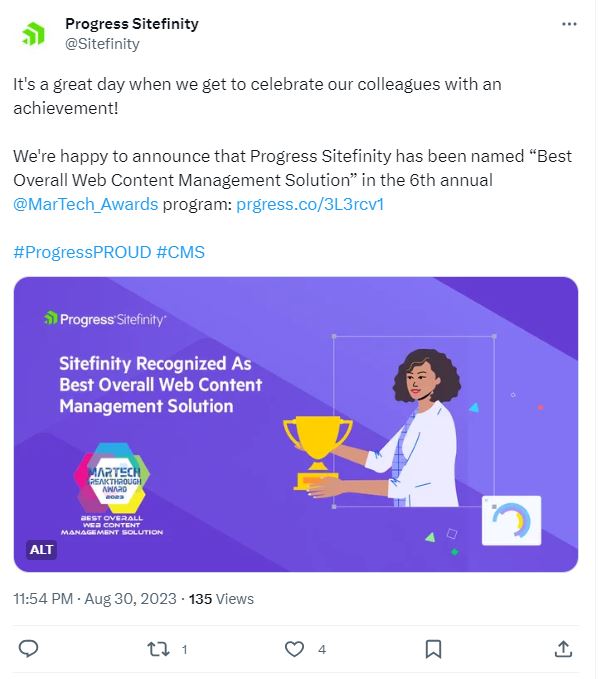
Should all websites have chatbots? (Image – Shutterstock)
Chatbot for websites: The role of generative AI and CMS
- Businesses are looking to implement a generative AI chatbot for their websites.
- Currently, most chatbots for websites are a copy of FAQs, frustrating customers.
- Generative AI chatbots can be integrated into a CMS for better business opportunities.
With the generative AI hype continuing to influence business decisions, it was only a matter of time before considerations were made on implementing the technology in content management systems (CMS). While some processes in the CMS can be automated, generative AI is expected to enhance the entire experience.
Take chatbots, for example. Almost all websites today have a chatbot. However, not every website is able to provide the best experience for customers interacting with a chatbot. In fact, Jay Sanderson, senior manager for digital experience at Progress, explained that a lot of companies have tried to build a chatbot that does too everything, and it ends up not doing anything well at all.
According to Sanderson, when businesses think about generative AI in CMS, they think about chatbots, which actually have been around for some time. Moreover, when chatbots debuted on websites some years ago, they didn’t really hit the expectations everyone had for them. Even today, most chatbots on most websites are not really able to provide users with the desired response and end up frustrating the users a lot more. This in turn leads to the brand losing customers.

Jay Sanderson, senior manager for digital experience at Progress
“Businesses create a chatbot that is simply a Frequently Asked Questions bot. That’s really just taking the contents of your Frequently Asked Questions page and putting it into a conversational interface. Some people might like getting their questions answered like that. For me personally, I’d rather just scan an FAQ webpage on my phone. My advice to companies that are looking at chatbots is first of all you need to think about it as a conversational interface that you’re going to push out to wherever it is that you believe your customers are,” said Sanderson.
He suggested businesses push the chat or conversational experience a customer would normally have physically through a channel where customers are going to be secondary to that. This can be achieved by focusing more on the quality of the chatbot rather than the quantity of chatbot skills.
“When you combine chatbot technology with segmentation and personalization capability, you have the opportunity to recognize when someone could utilize that chatbot skill. For example, if you go to your electricity provider’s website, and maybe they personalize the code in a way that recognizes that maybe you’ve just moved house or something like that. You’re likely to call them up to change some billing information, which might be the perfect intercept to introduce a chatbot which will not just answer your questions, but can actually carry out activities on your behalf,” explained Sanderson.
Put simply, Sanderson believes that by plugging the chatbot into external systems, not only is a consumer happy with the interaction, but they’re also able to save a lot more time instead of waiting to speak to human agents.

Is generative AI in CMS a possibility? (Image – Shutterstock)
Generative AI in CMS
When it comes to a chatbot for websites, Sanderson pointed out that there’s a huge amount of opportunity, especially when it comes to generative AI in CMS. In the next six months, businesses are going to see a lot of low-hanging fruit in terms of features that will be introduced into these environments.
“For generative AI in CMS, you’re going to see things like shortcut buttons. For example, using a generative AI plugin to give an SEO description. Some applications would even be about rewriting and editing content to appeal to a certain audience. While generative AI can do all this, it’s really just a shortcut.
If we look beyond that, I think there are some really valid use cases around using generative AI for classification, using generative AI for personalization and so on. Generative AI is really adaptable, and it’s got implications back to chatbots as well. For example, when a chatbot is explaining to a customer and the customer is confused, the chatbot has the ability to rephrase that on websites,” added Sanderson.

Progress Sitefinity delivers CMS solutions.
The chatbot, websites and CMS
Gartner describes CMS platforms as a set of templates, procedures and standard format software that enables marketers and their proxies to produce and manage text, graphics, pictures, audio and video for use in web landing pages, blogs, document repositories, campaigns of any marketing activity requiring single or multimedia content.
For Sanderson, Progress can help businesses in their CMS journey. It’s not just about updating and building a new CMS platform. Instead, businesses need to look at their CMS as a digital experience platform.
To achieve this, Progress Sitefinity’s intuitive, intelligent tools let businesses deliver unique experiences that drive ROI and reduce the total cost of ownership. It’s no longer just about updating legacy CMS platforms and investing in generative AI. The entire process should focus on improving the digital experience.
“We are helping people with content. We’ve got a solid product development trajectory. We’ve got lots of exciting announcements coming up with our current CMS. If people want to do headless, they can, if people want the traditional environment, they can have that too. We are one of the only kind of digital experience platform providers that offer a conversational interface development solution that’s through our product,” Sanderson concluded.
READ MORE
- Safer Automation: How Sophic and Firmus Succeeded in Malaysia with MDEC’s Support
- Privilege granted, not gained: Intelligent authorization for enhanced infrastructure productivity
- Low-Code produces the Proof-of-Possibilities
- New Wearables Enable Staff to Work Faster and Safer
- Experts weigh in on Oracle’s departure from adland






